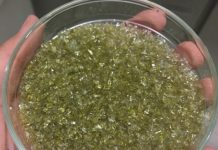Aarthi JanakiRaman, Research Manager, Chemicals and Advanced Materials at TechVision, Frost & Sullivan, argues that biofertilizers are a sustainable way ahead for agriculture
Modern agriculture is still increasingly dependent on synthetic inputs to ensure requisite yield and productivity. One of the widely used, in certain cases, abused inputs, are chemical or synthetic fertilisers. While various studies establish the fact that judicious use of synthetic inputs is acceptable, its adverse effects, in the long run, can’t be denied, the key one being the imbalance of the soil ecosystem, which can reduce yield and, in turn, increase the use of chemical inputs, resulting in a vicious cycle.
In recent years, the growing adoption of organic farming has resulted in a more sustainable approach towards agriculture as it emphasises on adopting environmentally benign practices to ensure food security while protecting and nurturing soil biodiversity. Stakeholders are adopting various strategies to make organic and sustainable agriculture mainstream; one of the key ones being the use of bio-based fertilizers or bio-fertilizers to provide optimum nutrients to crop and enhance soil potency.
With interest in sustainability on the rise, there is much effort targeted towards the development of organic and sustainable fertilizers as inputs. While these terms are often used interchangeably, a way of differentiating between them is through the source of origin. Most of the bio-based fertilizer inputs are of plant and microbial origin, while organic fertilizers include those of animal origin too. The term “biofertilizer” itself has been denoted in various ways over the past 10 years. At present, biofertilizers are widely used to denote substances that are incorporated with microbes or other living cells or organisms that can help in nurturing plant growth and promote soil health; it also denotes growth-enhancing substances that are bio-based or bio-derived in origin. Irrespective of the terminology used, the underlying concept remains the same.
Biofertilizers have come a long way from being seen as a supplement to chemical fertilizers to their current position as nutritional aids that can mobilise vital growth elements in an easily assimilated form. They are often regarded as a renewable source of plant nutrients and promote soil health and have become a vital constituent in integrated crop and soil management.
Role of biofertilizers to enhance soil microbiome
A key focus in line with promoting sustainable agriculture in the coming years is to focus on implementing eco-friendly methods to enhance the microbial ecosystem of the soil and to promote a diverse range of naturally occurring microbes to ensure sustained crop production activities. Various research studies have established that a naturally occurring ecosystem will flourish through the careful maintenance of beneficial soil micro-organisms. These microbes are diverse and help in maintaining the physicochemical properties of soil, ensure soil health and promote plant growth and crop yield.
One of the ways where biofertilizers can help in nurturing an optimum soil ecosystem is to provide sufficient organic matter to nurture the soil microbiome. Their ability to increase the population of microbial strains such as Azotobacter, Azospirillum, Phosphobacteria and Rhizobacteria help in providing optimum nitrogen cycling, which is critical to both soil and plant health. Biofertilizers help in enhancing nutrient availability and uptake by aiding nutrient solubilisation. They also help in producing plant hormones such as cytokines, help in stimulating proper root architecture and improving photosynthesis. This aids the plants to become more resistant to stress and pathogen attacks by producing metabolites. Thus, the use of biofertilizers has a twofold effect: enhancing soil health while promoting plant growth.
What next for biofertilizers?
It is important to analyse and adopt useful traits of biofertilizers into integrated soil management programmes for sustained and long-term benefits. While biofertilizers are gaining in popularity, there are still in the emerging stages of adoption.
Most of the current biofertilizers are targeted towards improving the macronutrient profiles such as nitrogen, potassium and phosphorus; targeted products are available for other minerals such as Zinc. Ongoing research efforts can help in developing biofertilizers with multifunctional nutrient profiles and with increased nutrient density; this can, in turn, help in ensuring holistic crop and soil health management.
Research that can help in ensuring the ability of the compound to be used along with other growth inputs without compromising on its or others’ intended action will also help in increasing its adoption.
There is a need for continuous R&D and product development efforts to integrate biofertilizers in modern agricultural practices. Molecular biotechnological tools are already being used to identify biochemical pathways; if this learning can be transferred to developing biofertilizers that can help in producing requisite hormones, it will go a long way for plants to overcome environmental stress and ensure crop yield.
Research on eco-friendly carrier materials that can help in encapsulating active cultures to ensure targeted and sustained action will also help improve the effectiveness of biofertilizers and enable them to increase their commercial adoption while overcoming their lower shelf life and temperature sensitivity, compared to liquid-based biofertilizers. Continued R&D efforts can also help in reducing the comparatively higher cost of liquid fertilisers, offering farmers a wider range of choices.
The final word
The changing agriculture ecosystem with its increased emphasis on sustainability plus holistic soil and crop health management has opened immense opportunities for bio-based fertilizers. Continued R&D efforts to ensure product efficiency and field trials are critical to ensure successful adoption in agricultural practices.
References
1. Mayanglambam, B., Thangjam, B. and Devi, N.M. 2020. Role of Biofertilizers in Sustainable Agriculture- Prospects and Constraints. Biotica Research Today. 2, 5 Spl. (May 2020), 345-347.
2. Mateusz Mącik, Agata Gryta, Magdalena Frąc, Chapter Two – Biofertilizers in agriculture: An overview on concepts, strategies and effects on soil microorganisms, Editor(s): Donald L. Sparks, Advances in Agronomy, Academic Press, Volume 162,2020, Pages 31-87, ISSN 0065-2113, ISBN 9780128207673, https://doi.org/10.1016/bs.agron.2020.02.001











